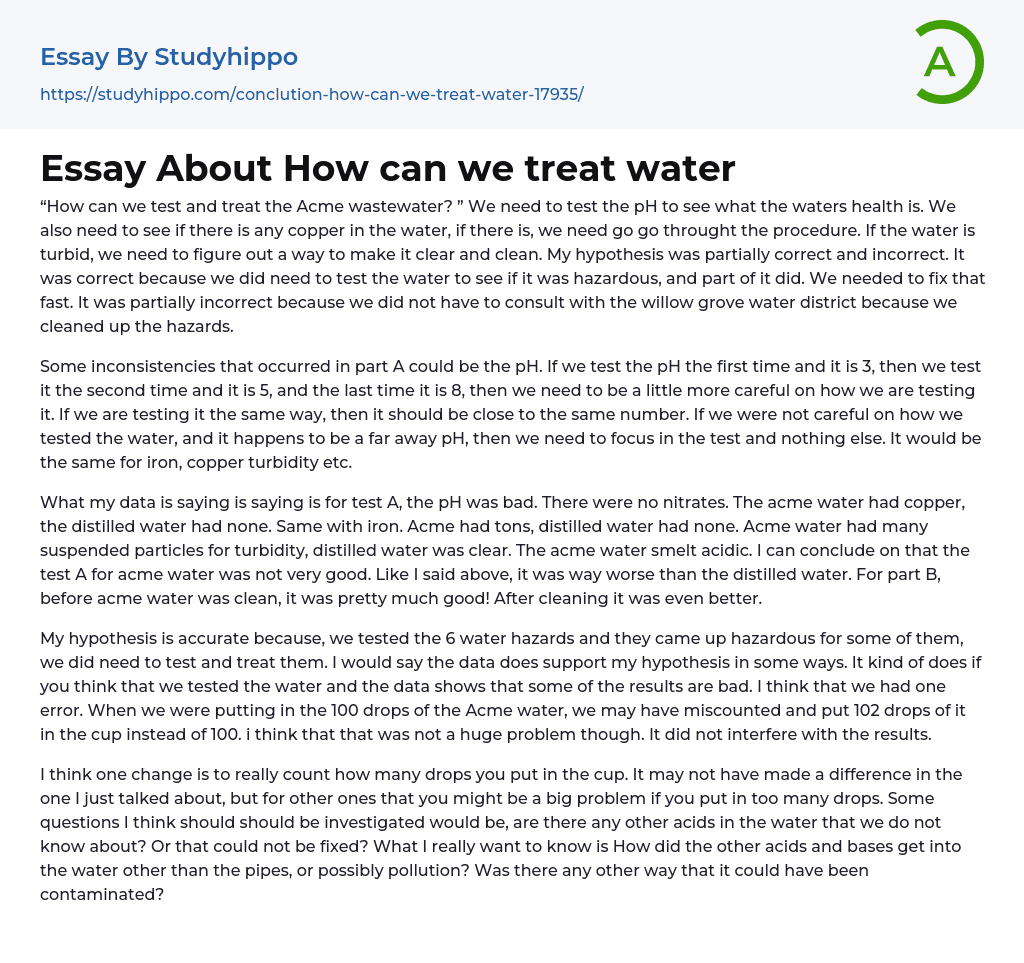"To evaluate the pH level of Acme wastewater and proceed with testing and treatment, it is crucial to assess its health."
Additionally, we must check for copper presence in the water. If copper is detected, we must go through the necessary protocol. In the case of turbidity, we must find a solution to clarify and purify it. My hypothesis was partially accurate and partially inaccurate. Testing the water for potential hazards was indeed necessary, as confirmed by part of my hypothesis.
In order to resolve the situation promptly, it was necessary to address errors. These mistakes were partially a result of not obtaining approval from the Willow Grove Water District, even though we had already addressed the hazards. Some discrepancies in Part A may be related to the pH level. For example, if the initial pH test gave a reading of
...3, the second test yielded a reading of 5, and the final test resulted in 8, we should be careful with our testing method. By using the same approach for testing, we can anticipate relatively consistent results.
If the pH level is found to be far from ideal during careful water testing, our focus should solely be on conducting the test. This principle also applies when testing for iron, copper turbidity, and other substances. Based on the data collected, it can be concluded that the pH levels were unsatisfactory for test A. No nitrates were detected. The acme water revealed the presence of copper, whereas distilled water showed no traces.
The amount of iron in Acme water was significant, while distilled water had no iron. Acme water contained numerous suspended particles, affecting its turbidity, whereas distilled water was
clear. Additionally, Acme water had an acidic smell. Based on these observations, I can conclude that the test A for Acme water was not satisfactory.
As mentioned earlier, the quality of acme water was significantly worse than that of distilled water. However, after undergoing the cleaning process in part B, its quality improved further. The accuracy of my hypothesis is confirmed by the examination of 6 water hazards, which revealed that some of them were indeed hazardous and required testing and treatment. Therefore, the data partially supports my hypothesis.
If we consider that we have tested the water and the data indicates that some results are negative, it actually matters. It seems that there was one mistake during the process. While adding 100 drops of the Acme water, we might have mistakenly put 102 drops into the cup instead. Nevertheless, I believe this minor error did not cause significant issues.
While it did not have an impact on the results, I believe one modification is to accurately track the number of drops added to the cup. Although it may not have affected the previous scenario I discussed, excessive drops could pose a significant issue in other cases. Several queries that require investigation include: are there any unidentified acids present in the water? Are there any unresolvable issues pertaining to these acids? What I am particularly curious about is how the water became contaminated with other acids and bases apart from the pipes or pollution. Is there any alternative explanation for its contamination?
- Child essays
- Childcare essays
- Child labor essays
- Doll essays
- Environment Pollution essays
- Plastic Pollution essays
- Bottled Water essays
- Adoption essays
- Aunt essays
- Babies essays
- Bedroom essays
- Caring essays
- Children essays
- Daughter essays
- Divorce essays
- Dog essays
- Dysfunctional Family essays
- Family Tradition essays
- Family Values essays
- Father essays
- Foster Care essays
- Friends essays
- Grandparent essays
- Home essays
- Hometown essays
- Husband essays
- Jealousy essays
- Love essays
- Marriage essays
- Mother essays
- Online Dating essays
- Parenting essays
- Parenting Teens essays
- Parents essays
- Relationship essays
- Room essays
- Sibling essays
- Sister essays
- Wedding essays
- Wife essays
- Acid essays
- Calcium essays
- Carbohydrate essays
- Carbon essays
- Chemical Bond essays
- Chemical Reaction essays
- Chemical reactions essays
- Chromatography essays
- Concentration essays
- Copper essays




